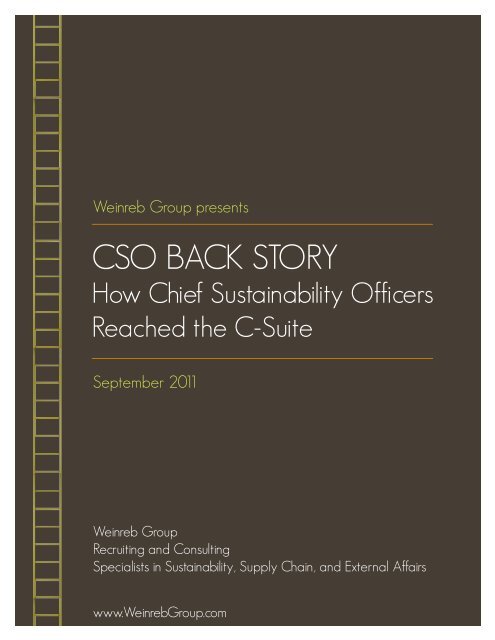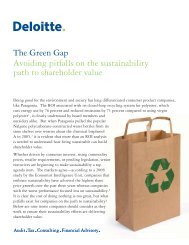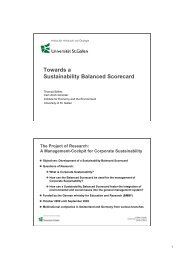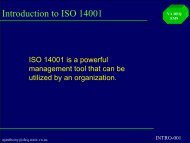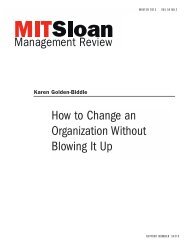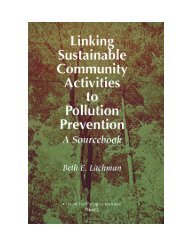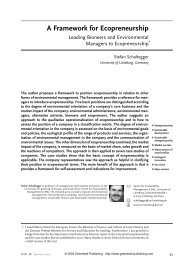CSO BACK STORY - Weinreb Group
CSO BACK STORY - Weinreb Group
CSO BACK STORY - Weinreb Group
- No tags were found...
Create successful ePaper yourself
Turn your PDF publications into a flip-book with our unique Google optimized e-Paper software.
<strong>Weinreb</strong> <strong>Group</strong> presents<strong>CSO</strong> <strong>BACK</strong> <strong>STORY</strong>How Chief Sustainability OfficersReached the C-SuiteSeptember 2011<strong>Weinreb</strong> <strong>Group</strong>Recruiting and ConsultingSpecialists in Sustainability, Supply Chain, and External Affairswww.<strong>Weinreb</strong><strong>Group</strong>.com
Table of ContentsForeword ................................................................................................................................................................3Executive Summary: Top 10 Findings & A CALL TO ACTION....................................................................4Introduction: 29 Chief Sustainability Officers ..................................................................................6The First <strong>CSO</strong> ......................................................................................................................................................7<strong>CSO</strong> Profile: Peter Graf, SAP........................................................................................................................................................................................................9Candidacy: What Makes a <strong>CSO</strong>?...................................................................................................................10<strong>CSO</strong> Profile: Charlene Lake, AT&T ...................................................................................................................................................................................12Corporate Governance and Strategy: Where Does the <strong>CSO</strong> Fit?..............................................13<strong>CSO</strong> Profile: Scott Wicker, UPS...............................................................................................................................................................................................15Organizational Structure: The Nuts and Bolts of the <strong>CSO</strong>’s Team .............................................16<strong>CSO</strong> Profile: Kathrin Winkler, EMC..................................................................................................................................................................................18Makings of a Successful <strong>CSO</strong> .................................................................................................................19<strong>CSO</strong> Profile: Linda Fisher, DuPont.......................................................................................................................................................................................22Best Practices: The <strong>CSO</strong> ..............................................................................................................................23Rankings vs. Title: Is Green the Right Measure? ..............................................................................25Call to Action: COmpanies...........................................................................................................................26Call to Action: Sustainability managers...............................................................................................27Methodology ...................................................................................................................................................28Acknowledgements ......................................................................................................................................29AppenDix..............................................................................................................................................................30<strong>CSO</strong> Back Story<strong>Weinreb</strong> <strong>Group</strong>
Foreword ByEllen <strong>Weinreb</strong>CEO, <strong>Weinreb</strong> <strong>Group</strong>The person in charge of corporatesustainability and corporate socialresponsibility has evoloved, from alargely director level position, to vicepresident to chief, over the last decade.As the sustainability function creptup the corporate ladder, so has thecaliber of the person leading it. Thuswe have the title “Chief SustainabilityOfficer,” which implies the senior-mostsustainability leader in the senior-mostpossible position.Two years ago, the New York Timescalled this emerging role a “swellingof the C-suite 1 .” But nothing out theredefines or questions the role’s scope.As an executive recruiter 2 who haswatched and worked in the sustainabilityfield now for 15 years, I have seenfirsthand the evolution of this professionfrom a discretionary cost to a strategicnecessity. However, little attention hasbeen paid to this title – no data, nodefinition, no best practices.In 2010 I wrote an editorial for GreenBiz,where I questioned the definition andthis varying use of the term “ChiefSustainability Officer 3 .” I even made aan early attempt at the definition, whichjust scratched the surface. It was thenthat the idea for <strong>CSO</strong> Back Story wasborn.I felt that companies struggle with whatto call it, where to put it, and who tolead it would appreciate some real data.Even a list of <strong>CSO</strong>’s does not exist todate. It was my intention in <strong>CSO</strong> BackStory to conduct exhaustive research togenerate 1) a <strong>CSO</strong> list, and 2) a study ofhow they arrived to their role today.To structure the research, I createdspecific criteria. I decided to focus onU.S.-based individuals who had “ChiefSustainability Officer” in their title at acompany traded publicly in the UnitedStates.My team and I found 29 4 .While the criteria for the researchrequired the title “Chief SustainabilityOfficer,” there are many sustainabilityleaders who hold other titles. Becausetitles remain diverse across industries,this report develops best practices forthose in the senior-most role regardlessof their official title.My research uncovered several startlingfacts and identified a roster of bestpractices that the profession sorelyrequires.In the next few pages, you will seethe first-ever data driven report of itskind analyzing and encapsulating theessence of a crucial and emergingexecutive role: the Chief SustainabilityOfficer. You will understand this role in itsentire complexity and scope, learn fromexamples, see firsthand the evolutionof these chiefs, and gain valuableperspectives into how organizationsdefine and implement sustainability.We owe many thanks to the people whosupported the methodology, research,content, editing and reviewing of <strong>CSO</strong>Back Story.1Companies Giving Green an Officer http://www.nytimes.com/2007/07/03/business/03sustain.html?pagewanted=22The <strong>Weinreb</strong> <strong>Group</strong> http://weinrebgroup.com/3In search of the elusive <strong>CSO</strong>: http://www.GreenBiz.com/blog/2010/04/01/search-elusive-chief-sustainability-officer4We included Georgia Pacific even though it is not publicly traded. We felt compelled to include GP because of its sheer size and the fact that it had been public until 2005, when it was acquired by KochIndustries for $21 Billion.<strong>CSO</strong> Back Story<strong>Weinreb</strong> <strong>Group</strong>
EXECUTIVE SUMMARY:TOP 10 FINDINGS & A CALL TO ACTIONFor years, businesses have pursuedsustainability. Perhaps not the green,social or environmental kind but certainlythe economic kind. Their shareholdershave made sure of it. Now, anotherkind of stakeholder has emerged, thatinfluences corporate behavior. They pushcorporations to recalculate the social andenvironmental consequences of doingbusiness.And some companies respond byrethinking how they strategize for thelong term. As SAP’s Chief SustainabilityOfficer Peter Graf says, “Make yourcorporate strategy a sustainable one.”Therein comes the latest executiveto join the powerful C-suite: the ChiefSustainability Officer.Lack of Clarity: Who is aChief Sustainability Officer?Further, no one has come forward tosuggest standardized guidelines on thescope and authority of the role. Wheredo the vice-presidents, directors, andmanagers rank in authority, power andleadership alongside the sustainabilitychief? How should companies choose?For example, there aren’t many roles inthe pantheons of corporate leadershipthat require the healthy dose of humilityand anti-hero capabilities that wefound <strong>CSO</strong>’s to hold. One <strong>CSO</strong> evencalls it having a “very low score on themegalomanic meter.”Or that holds responsibility for internalbehavioral and cultural change whilealso being the external representative ofthe company.Sustainability Chiefs byAnother NameThis report, then, provides acomprehensive look at the role of a ChiefSustainability Officer by charting theevolution of the 29 executives who holdthis title among US public companies andanalyzing their responsibilities.We focused on researching thosewho specifically hold the title “ChiefSustainability Officer” because weassumed that this select group wouldbe at the executive level - close to theCEO, and perhaps on an executiveteam involved with all corporate strategicdecisions – to support our efforts to gleanbest practices.We understand that the senior-mostsustainability executive might haveanother title that is equally as powerfuland influential and acknowledge thatthere are heads of sustainability that arenot on this list of 29, yet who follow all thebest practices laid out in this report.This report is aimed for not only thegrowing group of sustainability managersbut also companies who are looking forexamples, best practices and precedentsin charting their own sustainabilitystrategy.In the following chapters, you will get ataste of the role, a sense of its scope,and an understanding of its importancein today’s complex corporate structure.Independently verified, the data wascollected through publicly availabledocuments and vetted with the <strong>CSO</strong>sthemselves.A Call to ActionWhile research-based, this report alsoserves as an important call to action:For companies and sustainabilityprofessionals.As businesses, senior leadership mustrecognize that for sustainability to betruly and effectively embedded withinan organization, it must be rooted in topleadership and given the same strategicelevation as other operational functions.As for sustainability professionals, only29 companies among the roughly 7,000publicly traded companies [listed on theNYSE or NASDAQ] in the U.S. haveinstituted Chief Sustainability Officers.That’s a big opportunity for sustainabilityprofessionals.Use this report and the successes notedin these pages to make your case as asustainability manager. Don’t use the<strong>CSO</strong> term lightly. Share this report withyour colleagues and senior leadership.Question the current reporting structure,pry apart linear hierarchies, andunderstand how sustainability canbecome your company’s differentiatorover the long term.<strong>CSO</strong> Back Story<strong>Weinreb</strong> <strong>Group</strong>
EXECUTIVE SUMMARY:TOP 10 FINDINGS & A CALL TO ACTIONKey FindingsWhile each finding represents a crucialelement of how business is conductedwhen sustainability is an integratedprocess, here are our top 10 findingsthat form the basis of the chapters thatfollow:1. Emerging Executive Role: Thereare 29 <strong>CSO</strong>s (people with that title) atpublicly traded companies in the US.2. The Secret Sauce: Chief sustainabilityofficers are business veterans whoare good at leading new initiativesand cross-functional teams, and whounderstand how to translate externalfactors into internal opportunities.3. More <strong>CSO</strong>s Appointed Each Year:This role is emerging. Linda Fisherwas the first <strong>CSO</strong>, appointed in 2004at DuPont. Next to follow was Ed Foxat Pinnacle West in 2006. Kellogg’s<strong>CSO</strong> Diane Holdorf is the first <strong>CSO</strong> tosucceed another <strong>CSO</strong>, Celeste Clarkewho is set to retire later this year.4. Knows the Business: Theseexecutives know the business. Theyhave worked their way up through theranks and were at the company foran average of 16 years before beinggiven the <strong>CSO</strong> title. Twenty-five outof the 29 were selected internally forthis role. Only four were new hires.5. Strong External Affairs Background:Of the 25 <strong>CSO</strong>s (we did not includethe four <strong>CSO</strong>s who were new hires),nine held an external facing role priorto being named <strong>CSO</strong>.6. Few Resources: With an averageof 4.2 direct reports, these <strong>CSO</strong>s runnimble operations with few resourcesbut a growing, often company-wide,team supporting their efforts7. Operational Freedom: All 29 havetheir own budget but not necessarilytheir own P&L.8. Close to the CEO: Ninety percent of<strong>CSO</strong>s are one or two steps removedfrom the CEO, with 10 out of 29[35%] reporting directly to the CEO.A further 16 [55%] are no more thantwo degrees removed, reporting toanother C-level executive such as theCOO or CMO.9. Not Many MBAs: The group’seducational background is diverse; astheir highest degree of education, ninehold a bachelor’s degree, 17 hold amaster’s degree and three hold PhDs.Of the Master’s, there are four MBAs,five JDs, three graduates of publicpolicy, and seven science graduates.10. Involved in overall corporatedecision making: Twelve of thesurveyed <strong>CSO</strong>s sit on an executivecommittee responsible for allcorporate strategic decisions, not justsustainability.<strong>CSO</strong> Back Story<strong>Weinreb</strong> <strong>Group</strong>
INTRODUCING 29 CHIEF SUSTAINABILITY OFFICERSWe hereby present the current list of 29 Chief Sustainability Officers in order of company size. These <strong>CSO</strong>s are based in the UnitedStates and work for companies publicly traded in the United States.Chief Sustainability Officer Company <strong>CSO</strong> since Revenue ($M) 6Charlene Lake AT&T 2009 124,280James Gowen Verizon 2009 97,354Dave Kepler Dow 2007 57,514Scott Wicker UPS 2011 51,486Edwin Pinero Veolia Water North America 7 2010 46,099Bea Perez Coca-Cola 2011 35,119Linda Fisher DuPont 2004 32,733Bill Frerking Georgia-Pacific 8 2007 27,000Kevin Anton Alcoa 2007 21,013Kathrin Winkler EMC 2008 17,015Peter Graf SAP 9 2009 16,517Jerry Lynch General Mills 2010 14,797Steve Kline PG&E 2009 14,628Roberta Bowman Duke Energy 2008 14,272Diane Holdorf Kellogg 2011 12,397Dennis Treacy Smithfield Foods Inc. 2010 12,203Roger McClendon YUM Brands 2010 11,343John Gardner Novelis 2011 8,673Gary Lawrence AECOM 2010 6,546Bill Kilbride Mohawk Industries, Inc. 2009 5,319Frank O’Brien-Bernini Owens Corning 2007 4,997Mark Greenlaw Cognizant 2010 4,592Cynthia Curtis CA 2010 4,429Mike Kelley YRC Worldwide 2008 4,335Edward Fox Pinnacle West 2006 3,524David Clary Albemarle Corporation 2008 2,363Paul Gilman Covanta Energy 11 2008 1,582Jack Rizzo ProLogis 2009 909Laurie Fried West Marine 2007 6236Source: Hoovers 7 European company traded in Europe and the United States 8 We decided to include them on our list even though they are not currently publicly traded. They have been publicly traded for much of their history. 9 European company traded inEurope and the United States 10 Diane is Kellogg’s second <strong>CSO</strong>. Celeste Clark took on the role in 200 and will retire this year. 11 The parent company is Covanta Holdings. Majority of Covanta Holdings is Covanta Energy.<strong>CSO</strong> Back Story<strong>Weinreb</strong> <strong>Group</strong>
THE FIRST <strong>CSO</strong>The title, Chief Sustainability Officer,connotes different things to differentpeople -- and across industries. Withindustry-specific variations common,companies tend to seat this role ina number of departments, includingcompliance, marketing, public affairs,and operations.What to call the leader of this functionvaries. The options are long andcomplicated with no formal guidelinesdictating a sustainability chief’s scopeof work. Many refer to the term “chiefsustainability officer” as the senior-mostexecutive in charge of a company’ssustainability activities. To narrow ourresearch, we wanted to study seniormostsustainability leaders who werealso at the very senior seats offered attheir company. We chose <strong>CSO</strong>’s whoformally hold this title “Chief SustainabilityOfficer.”In 2010, Ellen <strong>Weinreb</strong> wrote a GreenBizarticle 12 questioning the semantics of thetitle, <strong>CSO</strong>. She confessed that the firsttime she had heard about the title -- andshe has been in this space for almost15 years -- was from a reporter back in2006 who was developing a story on theemergence of the <strong>CSO</strong>.At that time, Ellen told the reporter thatthe title did widely not exist, and the storywas dropped. However, the position didexist, and has continued to evolve witha widely diverse palette of duties and nodefined parameters of job responsibilitiessince. Writing in 2010, she ended with ahopeful prediction:<strong>CSO</strong> Back Story“Few big companies operate without aCEO, COO (chief operating officer) andCFO (chief financial officer). Many haveCMOs (chief marketing officer). Whenthey are joined in the C-Suite by the<strong>CSO</strong>, we’ll know that sustainability hasfinally become integral to the core ofbusiness.”As she had predicted, some companieswere starting to take note. In 2004,DuPont 13 appointed Linda Fisher as itsChief Sustainability Officer, making herthe first <strong>CSO</strong> among America’s publiclytraded companies. Today, there are 29.Fisher, who graduated with a Bachelorsdegree in History and later went on toearn an MBA and a JD, is one of onlyeight women Sustainability Chiefs. Anindustry veteran, Fisher, unlike mostother <strong>CSO</strong>s, was an external hire. Beforejoining DuPont, she served as the DeputyAdministrator for the U.S. EnvironmentalProtection Agency (EPA). Her expertise:Environmental, Health and Safety.The past seven years have seen Fisher’swork constantly increase in scope. Today,she is not only in charge of environmentalhealth and safety but also owns DuPont’sCSR reporting process, compliance andgovernment affairs, as well as its productstewardship and regulatory affairs.There has been noone true and testedpath to the chiefsustainability officer’schair.However, as you will see magnifiedfrequently in the next few pages, therehas been no one true and tested path tothe chief sustainability officer’s chair.Being a leader in an emerging sectorbrings with it several challenges, butmost importantly, a lack of precedent;i.e., there are no guidance or successmodels to follow. Fisher’s mission wasclear: to tie the sustainability strategy tothe company’s overall strategy.For Fisher, the position evolved fromdecades spent in environmental research,safety and policies. For PG&E’s SteveKline, the path involved internationalpolitics, economics and a Master’s inDiplomacy. Today, he reports directlyto the CEO and handles the company’sfederal affairs as well.What is clear, say Fisher, Kline andthe other <strong>CSO</strong>s we interviewed, is thatthe strategic necessity of their roleis increasingly becoming obvious toorganizations.<strong>Weinreb</strong> <strong>Group</strong>
THE FIRST <strong>CSO</strong>CSR Rising through the Executive RanksSource: 2009 CSR Jobs Report: The <strong>Weinreb</strong> <strong>Group</strong> 14The diagram above shows the promotionof the sustainability function from 2004 and2009. Based on <strong>Weinreb</strong> <strong>Group</strong>’s research,we found that the number of Vice Presidentand Director level job postings on the risefrom 2007 to 2009. This suggests thepromotion of sustainability and corporatesocial responsibility within the corporation.It is a natural progression for the Chief titleto come next.Another driver for this sustainability rolebecoming more senior is the increasingcomplexity of the Global Reporting Initiative(GRI). In fact, CSR and sustainabilityreporting might be one of the primaryfactors -- if not the main one-- for thisemerging executive role.As UPS <strong>CSO</strong> Scott Wicker put it, “GRIis asking for such complex data andaccountability, that it requires a top downdeliberate focus on sustainability. Wewere constantly hunting for data in anuncoordinated manner. As the questionsbecame more and more sophisticated, werealized that our governance structure hadto change as well.”In the next segment, we examine thecandidacy of the <strong>CSO</strong>: What have beensome of the commonalities in their careertracks; are they sustainability experts orbusiness insiders; and is an MBA key forthis position?142009 CSR Jobs Report: <strong>Weinreb</strong> <strong>Group</strong> http://weinrebgroup.com/wp-content/uploads/2008/01/CSR-Jobs-Report-2009-FINAL.pptx<strong>CSO</strong> Back Story<strong>Weinreb</strong> <strong>Group</strong>
Peter Graf, SAP:Business Veteran, Sustainability AmbassadorPeter Graf, 44, loves teaching, publicspeaking and technology. His father,a science teacher by profession anda technophile at home, taught Graf toembrace change and to appreciate thevalue of resources. “We weren’t the mostwell-to-do but he really added depth ofthought to everything we consumed,” hesays.Graf went on to a master’s degreein computer science, a master’s inengineering and topped it off with a PhDin artificial intelligence.With this understanding of processesand systems, today Graf leads softwaremakerSAP’s sustainability team and isthe company’s first Chief SustainabilityOfficer. A company veteran, he startedworking at SAP in 1996, and mostrecently served as its EVP for Marketingbefore being named <strong>CSO</strong>.While he wasn’t an external hire for the<strong>CSO</strong> role, the title was, in fact, a newventure for SAP, a strategic decision inresponse to market forces, accordingto Graf. “It was clear from the startthat the sustainability topic is going tobe big,” he says. What followed was aone-hour meeting with SAP’s CEO in2008 and a six-month exploration of theopportunities around sustainability.“I met [the CEO] in July 8, 2008. My newrole was then publicly announced onMarch 2, 2009.”We asked Graf to describe theindicators that something is going tobe “big”. “Sustainability is similar inimpact and transformational power asprevious business megatrends such asglobalization or the introduction of theinternet in business. They are inevitable,irreversible and foundational. That’swhy building sustainability into SAPsolutions can really change the world,”he says. Also starting to become clearwas the intense competition brewing inthe software sector to push sustainableproducts out to the market. “As themarket leader in enterprise software,we are condemned to stay ahead of thecurve,” Graf acknowledges.“The real challengeis making your corporatestrategy a sustainableone rather than onlycreating a sustainabilitystrategy.”-Peter GrafGraf’s ability to observe externalforces and leverage them into internalopportunities isn’t the only quality thatmakes him an ideal <strong>CSO</strong> candidate.His tenure at the company was crucialin driving sustainability on the board’sagenda -- and today helps him getstakeholders on the table and programsinto implementation faster.“The ability of a <strong>CSO</strong> to influence anddrive sustainability is correlated to theirability to drive value for the company,”he says. To date, SAP has avoided aquarter of a billion dollars in costs dueto its internal sustainability efforts. Butit has also helped create the market forsustainability solutions for its customers.“SAP’s corporate mission of helpingthe world run better ties perfectlyinto sustainability. In fact, we seesustainability as our purpose,” he says.His advice for aspiring sustainabilitymanagers and directors: “The realchallenge is making your corporatestrategy a sustainable one rather thanonly creating a sustainability strategy.”<strong>CSO</strong> Back Story<strong>Weinreb</strong> <strong>Group</strong>
Candidacy: what makes a cso?Outward-facing road mapWhen we launched our research, weexpected the path to the <strong>CSO</strong> title tohave included a major component ofEnvironmental, Health and Safety (EHS)responsibilities. We were very wrong.Instead we found several <strong>CSO</strong>s who hadpreviously held external facing roles.Of the 25 <strong>CSO</strong>s (we did not include thefour <strong>CSO</strong>s who were new hires), nine(36%) held an external facing role priorto being named <strong>CSO</strong>. Four of thosenine were environmental external affairs.This brought us to the conclusion that thecandidates picked for the <strong>CSO</strong> role tendto have outward facing external affairsexperience rather than a strong EHSbackground.With much being said in the media aboutsustainability increasing as a strategicfunction, we also expected to see amajority of former SVPs and VPs ofsustainability being promoted to <strong>CSO</strong>.Not so, say our 29 <strong>CSO</strong>s. Of course,there are many more VPs, directors andmanagers of sustainability and CSR than<strong>CSO</strong>s, and while no less important, thesetitles remain distanced from the authorityof the C-suite. While many report intothe C-suite, their potential remainsunderexploited.Unsurprisingly though, we also foundthat the vast majority (86%) of therespondents were selected internally.While their previous titles represent a widediversity of experiences and knowledge,here is a list of our respondents with theirmost recent titles before <strong>CSO</strong>:Previous TitleTotalExternal Affairs 5Environmental Affairs 4Research 4Operations 3Marketing 3Head of Business Unit 2Finance 1Legal 1Sustainability 2Grand Total 25Surprisingly, only two <strong>CSO</strong>’s hadsustainability roles before the <strong>CSO</strong> title.For example, Bill Frerking, the <strong>CSO</strong> ofGeorgia-Pacific, the only not-publiclytradedcompany included in this report,was previously Chief Counsel for BuildingProducts. Coca-Cola’s Bea Perez, alsothe youngest <strong>CSO</strong> at age 41, servedas the food and beverage giant’s ChiefMarketing Officer for Coca-Cola NorthAmerica before taking on the mantle ofsustainability.36% of <strong>CSO</strong>s held anexternal facing roleprior to beingnamed <strong>CSO</strong>.<strong>CSO</strong> Back Story10 <strong>Weinreb</strong> <strong>Group</strong>
Candidacy: what makes a cso?<strong>CSO</strong>: Industry and BusinessVeteransOn average, <strong>CSO</strong>s have been with theirrespective companies for 16 years.Moreover, 86% of them were internalhires.As their roles evolve and adapt to afast-changing environment, the onecommonality in their success is a long-termunderstanding of the organization. With amajority of the <strong>CSO</strong>s having risen throughthe ranks, it is a C-suite role that requiresa deep systems grasp of the challengesspecific to the company’s sector and globalenvironment.UPS’ Scott Wicker offers the classicexample. He started with the company in1977 and has risen within the ranks bybuilding on his engineering training withan understanding of the operations andchallenges of the freight and packagingsector. Today, he reports to the ChiefOperating Officer and manages thecompany’s Sustainability Report, humanrights, supply chain, compliance, as wellas environmental sustainability.Peter Graf presents a similar track. Afterjoining SAP in 1996, Graf worked on avariety of roles before being named <strong>CSO</strong>in 2009. His strengths: An engineeringbackground, a systems approach, and adeep understanding of SAP’s organizationalstructure, internal challenges and externalopportunities.Education: The PerfectDegree for a Career inSustainabilityOkay, that’s a teaser. There really remainsno one clear degree that guarantees asuccessful career path in sustainability,primarily because of the intense need forprofessionals who understand businessoperations and strategy, as well asenvironmental and social complexities.Of the 29 <strong>CSO</strong>s we surveyed, three holdPhDs, 17 have master’s degrees astheir highest level of education, with theremaining nine holding bachelor’s degrees.Of those with master’s degrees, we founda diverse group of lawyers, public andgovernment affairs experts, and MBAs(See below).Furthest Educational DegreeMasters: 59%Bachelors: 31%PhD: 10%We broke down the Master’s degree furtherand found the following:DegreeScience 7Business 5Law 5Public Policy 3Communications 1Grand Total 21When we began our research, we expectedmore <strong>CSO</strong>s to hold MBAs because ofthe speed business schools have shown(compared to other professional degreeprograms) in developing sustainabilityspecializations.As it turns out, however, an MBA does nottranslate into the <strong>CSO</strong> title. According to ourresearch, business experience and industryknowledge weigh much more heavily in the<strong>CSO</strong> selection than educational degree.For Graf, sustainability came by way ofengineering and learning how to createand innovate. For Kathrin Winkler, <strong>CSO</strong>of EMC, however, the path began witha bachelor’s degree in pre-med and alifelong passion for systems. “I’ve alwayshad an innate curiosity for understandingconnections and interdependencies. Somepeoples’ curiosity leads them to take thingsapart; mine was always about putting themtogether,” she says.15Calculated from Internal hires, not those new to the company.<strong>CSO</strong> Back Story11 <strong>Weinreb</strong> <strong>Group</strong>
Charlene Lake, AT&TCollaborator, Risk TakerPerhaps it was Charlene Lake’s years asa journalist that taught her to take risks.After graduating with a bachelor’s degreein journalism and mass communications,Lake spent a couple of years injournalism before joining AT&T in 1986.She dabbled in various communicationsroles, including financial, product andemployee communications, beforesettling into the external affairs function.“I was asked to start a public affairsprogram. Then I acquired thephilanthropic and volunteering efforts,and went on to build out an advocacyfunction for the company,” she recalls.Sustainability has arguably been practiceat the telecommunications behemoth forall 130 years of its existence, accordingto Lake, but it wasn’t an orchestratedeffort. But in 2007, there was arealization that, “our efforts needed tobecome more disciplined.” Lake, alongwith a colleague and a supportive boss,got the CEO’s buy-in. Soon thereafter,instituting sustainability as a strategicfunction reached the board of directors.“Not only did the board receive ourproposal well, they also included a newcorporate citizenship charter in theirexisting public affairs committee,” shesays. Contrary to most of the companieswe researched for this report, Lake, whowas named Chief Sustainability Officerin late 2007, continues to sit out AT&T’sexternal affairs function.“There was a lot of discussion aroundwhere to seat the function. We chose[external affairs] because of a realizationthat sustainability for us meant beingin tune with our social, environmentaland community stakeholders, and theexternal affairs department was alreadyin sync with that,” she says.“Our discipline hasno roadmap to follow.We learn everything onthe job. There are situationswhen you have absolutelyno idea on whatto do next, you just haveto figure it out”-Charlene LakeLake’s journey through the company’scomplex organizational structure [SeePage ], hasn’t been without its risks.In fact, she credits the abilities to“recognize when a door is open andthe courage to walk through it” as beingcrucial in her success as a <strong>CSO</strong>. “Ourdiscipline has no roadmap to follow. Welearn everything on the job. There aresituations when you have absolutely noidea on what to do next, you just have tofigure it out,” she says.She also believes that the perfectsustainability chief must “score poorlyon the megalomaniac meter.” Lakeexplained: “there is a high degree ofauthority without control in this functionand that means occasionally youneed to give credit to others who aredeserving and be okay with not sharingthe spotlight. Your goal shouldn’t be tobe the headline.”Lake understands that as a disciplinedprofession, the industry is in very earlystages. Her expectations -- and herleadership’s -- are therefore measured. “Idon’t want to build a sustainability empire.That’s not what the company needs. Thecompany needs sustainability integratedwith every function and championsin every corner. For that to happen,sometimes you have to step back andtake one for the team,” she says.“Your ability to connect your workand initiatives with the success of thecompany is critical. That means youhave to go beyond the ‘what’ into the‘why’ of your actions. That takes a gooddeal of courage, belief, confidence andthe ability to take risks. To lead, youhave to be the one to take the first step,”she advises.And that’s the kind of people she prefersto hire. “Ambiguity is a really helpful traitin this discipline.”<strong>CSO</strong> Back Story12<strong>Weinreb</strong> <strong>Group</strong>
Corporate Governance And Strategy:Where Does The <strong>CSO</strong> Fit?A Seat at the ExecutiveTableA necessary precursor to leadingcompany-wide cultural change istrue commitment from the top. Whilethe role of a Chief SustainabilityOfficer has continued to evolve, LindaFisher’s appointment in 2004 set offset off a consistent promotion of thesustainability profession as a whole. Inrole and responsibilities for sustainabilityexecutives as shown in the chart below.987654321Number of <strong>CSO</strong>’sAppointed By Year0 2004 2006 2007 2008 2009 20102011‘H1Companies have had environmentalmanagers and compliance officers doinga variety of functions for a long time, butnow, due to several colluding factorsand an urgency in the marketplace,sustainability is finally rising to the topechelon of leadership.With these C-suite executives all reportingone to two steps away from the CEO,their executive powers today are on parwith the other functional heads of theorganization, i.e., finance, technology,information and operation, indicating thatsustainability as a business imperativeis finally becoming an integral part oforganizational strategy. By investingin and appointing executive-levelsustainability chiefs, these companiesare committing themselves to pursuing along term sustainability strategy.Succession Planning: The<strong>CSO</strong> is Here to StaySuccession planning is a significantexercise for members of the C-suite toensure that these main functional areasare never without an executive in charge.Succession planning signifies the criticalnature of these roles, and in recent yearsit has become an imperative to maintaina trained line of executives who cantake on the leadership role as and whenneeded.This research reveals that the officeof the <strong>CSO</strong> is not much different.With the relatively recent arrival of thesustainability chief to the C-suite, ourresearch identified only one successionstory. That of Diane Holdorf at Kellogg.Holdorf, formerly VP of EnvironmentalStewardship, succeeded Celeste Clarkwho is set to retire later this year.When succession planning becomes derigueur for the <strong>CSO</strong>, sustainability hastruly become a company priority.Sustainability is finallyrising to the topechelon of leadership.<strong>CSO</strong> Back Story13 <strong>Weinreb</strong> <strong>Group</strong>
Corporate Governance And Strategy:Where Does The <strong>CSO</strong> Fit?Diversity of Duties: AnAdvantage in the C-SuiteIt is also important to note that the sheerdiversity of a <strong>CSO</strong>s’ duties actually helpsher get the other executives on theleadership team to buy in.In fact, 17 of the 29 <strong>CSO</strong>s havesustainability as their sole responsibility,with another 12 having dual jobs. Thatsecond function, echoing our findingregarding previous title, is largely externalaffairs related. Additionally, five haveexternally facing second roles (publicaffairs, community affairs, externalaffairs) and two had environmental,health and safety responsibilities.AT&T’s <strong>CSO</strong> Charlene Lake, for example,emphasized that it’s essential to “be ableto recognize when a door is open andhave the courage to walk through it” whenneeded. Lake’s emphasis underlinesthe most important responsibility of thisrole: Managing several buckets of dutieswith an eye on collaboration, changemanagement, and how they lend to thecompany’s reputation and long termstrategy.Scott Wicker expressed similarsentiments. Having risen throughUPS’ ranks and served as the VP forSustainability before taking on the chief’srole early this year, Wicker has seenfirsthand the immensity of strategicoversight and input the complex role canallow you with senior leadership and theboard.“It is important that the company’sgovernance structure ensures the seniormostperson in charge of sustainability ison par with the other top operational andfunctional executives,” he says, addingthat this helps not only demonstrate theessentially of the company’s commitmentto sustainability top down but to the boardand shareholders as well.CSR Reporting:Championing SustainabilityA crucial aspect of these <strong>CSO</strong>s’responsibilities is preparing annual CSRreports. With increasing complexitieswithin the Global Reporting Initiative(GRI) and the Carbon Disclosure Project(CDP), the pressure -- and competition-- is on for companies, big and small,to make their mark on the sustainabilityboard game by reporting on theirsustainability goals and challenges.For UPS, increasing complexities withinGRI and CDP was an important part of thedecision to revise its governance structureto ensure there was a senior executivein charge of all sustainability activities,from reporting to implementation as wellas communication. “There was a mutualfeeling that the questions were constantlygetting more complicated and thatsustainability required more attention,”Wicker informed.It wasn’t until Bob Stoffel--UPS’ SVP forsupply chain, strategy, engineering andsustainability--retired that the companyrealized that “there actually wasn’t anyone person who was truly in charge ofsustainability.”“They felt the need to make it clear whowas responsible for leading sustainability,”he added. Today, as <strong>CSO</strong>, Scott Wickerreports directly to the COO UPS.As any sustainability professional wellversedin GRI guidelines will admit,the process of putting a sustainabilityreport together can be a time- and laborintensiveproject that requires a full timecommitment. Therefore the <strong>CSO</strong> needsto be in a central coordinating role integralto running the entire corporation.<strong>CSO</strong> Back Story14 <strong>Weinreb</strong> <strong>Group</strong>
Scott Wicker, UPS:Engineer, Company VeteranScott Wicker, 50, started his career withthe United Parcel Service (UPS) in 1977,also his first day of college. By 1983,when he graduated with a bachelor’s inelectrical engineering, UPS was alreadyhome. “UPS was in a major growth spurtand they were hiring engineers to buildtheir facilities. So off I went,” he says.Today, Wicker is UPS’ first ChiefSustainability Officer and handles“everything sustainability” for thetransportation and shipping company.At UPS, sustainability isn’t a newphenomenon. “Sustainability as afunction was always there at thecompany but it was very uncoordinated.A few people were pulling data andanswering questions on an ad hocbasis,” he says.In 2006, however, it was clear internallythat the firm needed to review thesustainability governance structure.The leadership team realized that, “Weneeded to evolve to get better. We alsoknew that we had to include all thedepartments since sustainability affectseveryone,” he says.What resulted was a new reportingstructure in 2007 which included asustainability group with a director, vicepresident, and five other staff. Scottwas that vice president. He reportedto Bob Stoffel, a senior vice presidentwho held other responsibilities includingCorporate Strategy and Engineering.In hindsight, though, Wicker admits thatthe structure was clearly transitional andexperimental.When Stoffel decided to retire early thisyear, the reporting structure becamea topic of discussion yet again. “ForStoffel, sustainability was just one ofmany responsibilities,” says Wicker,preventing him from making it a strategicfocus. Externally, pressure was buildingon providing more sophisticated dataand enhanced accountability. “Wewere constantly hunting for data in anuncoordinated manner,” he adds.“Sustainability hasnever been a hard conceptat UPS. But creatingan executive positionseems to have really cementedour commitmentand mission.”-Scott WickerIt was time to make it “crystal clear” whowas responsible for leading sustainabilityat UPS, and instead of SVP, Wicker wasnamed <strong>CSO</strong>. Revising their reportingstructure, Wicker now reports directlyto the COO with one direct report and astaff of seven overall.Wicker admits that while externalpressure provided the initial motivationto create the <strong>CSO</strong> role, the internalimpact was a real eye opener. “I had noidea how much impact this would haveinternally on employees. The company’scommitment to sustainability finally sentthe right signal to all the departments,”he says. “We were trying to conserveenergy and operate more sustainablyfor a long time. Sustainability hasnever been a hard concept at UPS. Butcreating an executive position seems tohave really cemented our commitmentand mission.”Of his current priorities, Wicker has thisto say: “I’ve been with UPS for a long timeand understand how everything works.Now it’s time to use my experience andrelationships to embed sustainabilityinto every function.”<strong>CSO</strong> Back Story15<strong>Weinreb</strong> <strong>Group</strong>
ORGANIZATIONAL Structure:The Nuts And Bolts Of The <strong>CSO</strong>’S TeamThe <strong>CSO</strong> in the C-SuiteTen <strong>CSO</strong>s report directly to the CEO.Another 16 are two steps away.Here’s how it plays out by numbers:Distance to the CEOReports Directly to CEO: 35%Two Steps to the CEO: 55%Three Steps to the CEO: 10%majority run very humble operations butwith significantly overarching impact.At SAP, for example, <strong>CSO</strong> Peter Graf,who reports directly to the CEO, has11 direct reports but works with a crossfunctional team of over a 1,000 employeesto achieve all his myriad duties,which include diversity and inclusion,employee volunteerism, supply chainsustainability, environmental initiativesand communications, and publishinga formidable multimedia CSR report 16 .He achieves this influence over 1000employees through 15 division leaderswho hold dotted line reporting to Graf.The <strong>CSO</strong>’s Team90% of <strong>CSO</strong>s are oneor two steps awayfrom the CEO inreporting structureThis indicates significant progress andelevation for sustainability professionals.Considering that the first <strong>CSO</strong> wasn’tappointed till 2004 (DuPont’s LindaFisher), followed by Ed Fox in 2006, it isencouraging to see that sustainability isfinally becoming an integral element ofthe corner office.Moreover, 12 of the surveyed 25sustainability chiefs sit on the senior-mostexecutive leadership team, responsiblefor all corporate strategic decisions, notjust sustainability.With great power comes greaterresponsibility, although you couldn’t saythat when you look at the average <strong>CSO</strong>’steam. Our research indicates that aOn average, surveyed <strong>CSO</strong>s have 4.2direct reports and an overall team ofapproximately 185 cross-functionalstaffers. Because of the diversity ofthe <strong>CSO</strong>’s responsibilities, most teammembers are virtual and spread acrossfunctional areas. As sustainability growsthrough the ranks at these companies,the governance structures are alsorevised to accommodate a real filteringof sustainability across the company.Take a look, for example, at AT&T’sorganizational structure: (See Page 30,Chart 1)Lake who reports to the EVP for Externaland Legislative Affairs, sits with the coreteam and has seven direct reports and anadditional eight staff members assistingher. In a complex structure like ours,16SAP’s 2010 CSR Report http://www.sap.com/about-sap/csr/index.epx<strong>CSO</strong> Back Story16 <strong>Weinreb</strong> <strong>Group</strong>
ORGANIZATIONAL Structure:The Nuts And Bolts Of The <strong>CSO</strong>’S Team“Collaboration is key to integratesustainability into multiple companyfunctions,” she says.For organizational structures like AT&T,the sustainability chief’s role oftenbecomes one of a change managerinstead of a project or product manager.As Winkler put it, the role of a <strong>CSO</strong> is oneof “a catalyst.” “Your job is to catalyzechange top-down and horizontally ina way that reaches every area of theorganization. It is a significant undertakingand it takes a complex governancestructure to make it all work,” she says.EMC’s structure, while visually morelinear, is no less complex. Take a look:(See Page 30, Chart 2)The complexities of such a structureremain as significant as AT&T’s moreparabolic setup. For a <strong>CSO</strong> to besuccessful, she needs to be resourceful,collaborative, and most importantly,a critical systems thinker who canobjectively engage every internalstakeholder across functions.Note that both structures emphasize localemployee champions leading to functionalleaders, and a senior leadership teamled by a C-suite executive. Sustainabilitymanagers and executives should usethese structures as guiding points inrevising their organizational structurearound a core component of sustainabilitystrategy.Further, research reveals that while most<strong>CSO</strong>s have been at their companies foran average of 16 years and are wellversedin company structure, operationsand strategy, on average, they haveonly been in their current role only since2009.Moreover, 12 of the 25 who respondedto the surveys sit on the senior-mostcorporate decision making bodyresponsible for all strategic decisions,not just sustainability.BudgetInterestingly, however, all the surveyed<strong>CSO</strong>s reported having their own operatingbudget but not all maintain independentP&Ls.This is something companies -- andsustainability executives -- must modifyfor the role to be truly effective. Acommitment to sustainability involvesgiving <strong>CSO</strong>s the independence andthe corresponding power to implementtheir ideas with built-in accountabilitystandards. After all, you cannot improvewhat you cannot measure.UPS is in a similar situation.<strong>CSO</strong> Scott Wicker emphasized thatfor years the budget for his team’sactivities has come from a wholelist of departments, including PR,communications, community relations,and HR. Now, he is in the process ofdetermining what his budget shouldlook like with the leadership team, andhopes to start the next fiscal year with anindependent budget.Wicker’s observation is spot on becausewithout financial independence, thesustainability function will risk beingmarginalized even though it sits in theC-suite.<strong>CSO</strong> Back Story17 <strong>Weinreb</strong> <strong>Group</strong>
Kathrin Winkler, EMC:Systems Thinker, Vocal Female ExecutiveWhen the <strong>CSO</strong> position was created atEMC, Kathrin Winkler recalls severalcolleagues asking her if it was writtenwith her in mind. “I told my boss Iabsolutely had to apply for this job,” shesays.Winkler credits the role to her passionfor sustainability and her backgroundin working horizontally to improvesystems. Her passion comes from aninnate curiosity for systems. “Somepeople’s curiosity leads them to takethings apart; mine has always been toput things together,” she says, adding,“With my kind of systems thinking andcuriosity there is no way I could haveended up in any other field other thansustainability.”A pre-med student in college, Winkler’scareer is anything but linear. Shehas worked in operations, consulting,enterprise management, softwareengineering as well as a short stint inmarketing prior to working at EMC as aDirector of Product Management beforeassuming her current role.Since her appointment in 2008, Winklerhas emerged as an authoritative voice ina field that, at the executive leadershiplevel, is predominantly a man’s club.One of only eight female <strong>CSO</strong>s in ourresearch, Winkler says the positionbrings most of the same challenges anyother influential position would pose fora woman with one exception. “If youare a woman in charge of sustainability,there is a risk of it being perceived as asoft program. You don’t want executivesto think of it as just a feel-good programand so women have to work harderto make it clear that sustainability is abusiness strategy,” she emphasizes.A strong believer in systems thinking,Winkler emphasized that sustainability isa “change management project.” “Beinga change agent and being able to workcross functionally helps me get the jobdone. You have to know the businessand the culture you operate in,” sheadvises.“The <strong>CSO</strong> title isnot just something youhave to earn. It is therole your company hasto realize it needs.”-Kathrin WinklerHer advice for aspiring sustainabilityprofessionals is cautionary: “You needto be willing to take risks, recognizethat you don’t know all the answers, bewilling to borrow ideas and be equallywilling to admit that you were wrong.”She also had specific advice forsustainability professionals who wouldlike to see the sustainability job elevated:“Be patient. Sell the value of the work,not just yourself. We did a really good jobof selling the critical need for someoneto focus strategically on sustainabilityat EMC. They didn’t hire me only basedon my personal value proposition. Youmust also be able to take gratificationfrom indirect results of your work.”That said, she agreed that the <strong>CSO</strong>title does accord proper authority toher work and helps achieve more,including “carrying a lot more weightwith stakeholders, both internal andexternal.”As for other women in the sustainabilityfield, Winkler suggests demonstratingmore assertiveness. “Take your seat atthe table. It’s easy and tempting to sitagainst the wall figuratively and literallywhen all the people around you aremuch senior. But you are the subjectmatter expert. Walk up and sit at thetable, figuratively and literally.”In the end, much like her journey atEMC, Kathrin Winkler puts the onusback on companies: “The <strong>CSO</strong> title isnot just something you have to earn. Itis the role your company has to realizeit needs.”<strong>CSO</strong> Back Story18<strong>Weinreb</strong> <strong>Group</strong>
Makings Of A Successful <strong>CSO</strong>What makes a successful chiefsustainability officer? As the roledevelops, evolves and emerges as anecessary and crucial element of the C-suite, what qualities help a sustainabilitychief achieve her goals?We put the question to all 29 <strong>CSO</strong>sand what emerged is the portrait ofan accomplished professional with apassion for sustainability and decadesof whetted business expertise. Whilethe respondents didn’t have manycommonalities in education or careerpaths, they did emphasize several keyrequirements:Change management:For EMC’s Kathrin Winkler, sustainabilityis all about catalyzing change. “You mustbe a great change agent and a systemsthinker 17 . You have to be someone whodoes not care to be a hero but takessatisfaction from being a catalyst,” shesays.In fact, each of the five <strong>CSO</strong>s weinterviewed emphasized their role aschange catalysts, but it was Winklerwho perhaps stated it best: “Our rolein sustainability is to influence andimplement behavioral and operationalchange. Regardless of whether youcall the role chief sustainability officeror something else, our function asexecutives leading sustainability strategyis that of change agents.”According to these chiefs, it takes17Peter Senge: Systems Thinking http://www.infed.org/thinkers/senge.htmyears of experience, a keen sense ofobservation and a nose for recognizingchallenges and being able to leveragethem to positive action. Or as Graf putsit: “The ability of a <strong>CSO</strong> to influence anddrive sustainability is correlated to theirability to drive value for the company.”Systems thinking:For Winkler, this again is a hugeprerequisite. When the <strong>CSO</strong> role wasposted, she felt like the description waswritten for her. Having had a history ofworking horizontally to improve systemswith some of her previous work focusingon sustainability, she rememberedseveral colleagues wondering if the jobdescription, had, in fact, been written forher.“It was my passion and system orientedbrain that made sustainability the perfectfield for me,” she says. “It’s all about makingthe connections and understanding thesocial and environmental community weoperate in,” she adds.Graf also has a deep understandingof processes and systems. Perhaps itwas his technological and engineeringbackground or simply a curiosity forprocesses. “Managing sustainability is theclearest leadership challenge today. Forme, it was always about making SAP’scorporate strategy a sustainable one,”he says, noting that the progress SAPhas made in recent years would havebeen impossible without a clear systemsthinking coordinating the efforts.Leveraging ExternalOpportunities into InternalInnovation:In Graf’s case, it wasn’t his individualpassion or persuasion that got seniorleadership thinking about sustainability.While it was certainly a gut reaction in thebeginning that “sustainability was goingto be huge,” nine months of explorationand heavy researching went on beforethe CEO announced a focused team onsustainability.“There was intense pressure in ourmarket to stay ahead of the curve,” hesays. In 2010, after SAP acquired ClearStandards, this focus accelerated. Todate, Graf’s department has created $14billion in savings for the conglomerate.It is this ability to recognize an externalmarket challenge and turn it into internalprogress that can often be the crucialdifference between a successful andlackadaisical sustainability strategy.Compounding that is the fact that,according to Lake, a <strong>CSO</strong>’s goals arenever constant. “Sustainability programsaren’t the kind that finish,” she says.“They are ongoing and can alwaysbe improved with innovation being animportant element. The ability to seeprograms outside the company that canbe translated into sustainability efforts isincredibly critical.”<strong>CSO</strong> Back Story19 <strong>Weinreb</strong> <strong>Group</strong>
Makings Of A Successful <strong>CSO</strong>Courage And The Ability toTake Risks:When you are a senior sustainabilityexecutive, it’s often taken for granted thatyou grew through the ranks with specialtyand expertise on your side. While thatmight be true for more functional roles,a Chief Sustainability Officer’s path isanything but straightforward. In fact, allthe <strong>CSO</strong>s we interviewed went to greatlengths to emphasize that their field takesa ton of gumption and steel.“You have to be able to take risks andrecognize that you don’t know all theanswers. You must be willing to borrow,ask for advice and be equally willing toadmit that you guessed wrong,” advisesWinkler.Edwin Pinero, <strong>CSO</strong> of Veolia WaterNorth America, adds: “Be cognizantof business drivers and organizationalstrategy. Realize that sustainability has tobe integrated into the company’s DNA.”For both Winkler and Lake, genderpresented subtle and not-so-subtlechallenges as well. While Winkler admittedthat the pressure to succeed is muchgreater for women, she emphasized thatgender had never slowed her down orbeen a factor in her career decisions. Yet,she did have one piece of advice: “If youare a woman in charge of sustainability,there is a risk of it being perceived as asoft program. You don’t want executivesto think of it as just a feel-good program.Women need to work extra hard to makesustainability a business strategy.”Personal Satisfaction Tied toCompany Progress:You must be happy being the catalyst,say the <strong>CSO</strong>s. If your purpose is to bethe hero, then this job isn’t for you. AsCharlene Lake remarked, “Attitude ishuge in this field. You cannot do well ifyou’re looking at being in the spotlightyourself.”“Sell the value of your work, not yourself.Most people in the sustainability fieldtake gratification from the role,” advisesWinkler, who says stressing the criticalneed for sustainability is what got her thejob, not personal achievements or value.“My father taught me to recycle and touse everything,” says SAP <strong>CSO</strong> PeterGraf. His father, a teacher by professionand a technophile by passion, instilled inhim an acute depth of thought and taughthim to question everything. “I appreciatethe value of resources. When SAP madethe decision to invest in a sustainabilitychief and team, it was born from a coremission of tying our corporate missioninto sustainability ‘to make the world runbetter,’” he says.And Graf isn’t alone. AT&T’s Lake,who grew through the ranks at thetelecommunications firm after abachelor’s in journalism and masscommunications, has similar advice: “It’simportant to your own success that yourcompany succeeds.” Instead of personalrecognition, she sought progress forAT&T’s sustainability programs.Resourcefulness:If there is one common denominatorthat underlines all these chiefs’ roles, itis that they run extremely lean functions,often spread across departments andgeographies. Our research, in factreveals that on average a <strong>CSO</strong> has nomore than four direct reports.“What becomes key to getting thingsimplemented is resourcefulness,knowing how to work the organizationalmatrix to get results,” says CharleneLake. Essentially, the <strong>CSO</strong> has influencewithout power. While their task is tocatalyze change across organizationswith thousands of employees and<strong>CSO</strong> Back Story20 <strong>Weinreb</strong> <strong>Group</strong>
Makings Of A Successful <strong>CSO</strong>multimillion dollar revenue, theirimmediate teams remain small.It clearly takes a mix of really knowinghow the organization works -- afterall, the average <strong>CSO</strong> has been at theircompany for 16 years -- and a doseof critical thinking. For UPS’ ScottWicker this meant maintaining strongrelationships and really understandingwho the decision makers are. For Winklerand Lake, experience working with leanteams and an anti-hero attitude.In fact, Lake also offered two tipsfor aspiring <strong>CSO</strong>s and sustainabilityexecutives: “Be generous with praiseand recognize champions across thecompany, as a way to make sustainabilitya part of everyone’s efforts. And keepthe business in the spotlight; make sureeveryone is behind it.”“-CharleneAttitude is hugein this field. You cannotdo well if you’re lookingat being in the spotlightyourself.”Lake<strong>CSO</strong> Back Story21 <strong>Weinreb</strong> <strong>Group</strong>
Linda Fisher, DuPont:Trailblazer, Regulatory ExpertLinda Fisher didn’t know any other chiefsustainability officer when she assumedthe role at DuPont in 2004. All she hadwas a background in environmentalregulation and a deep interest ingovernment affairs.One of only four external hires out of all29 <strong>CSO</strong>s, Fisher had recently left herposition as the Deputy Administratorwith the Environmental ProtectionAgency (EPA), when a commonconnection at DuPont alerted the boardto her availability and experience in theregulatory environment.The then-Environment, Health andSafety (EHS) Director had just retiredand then-CEO Chad Holliday wanted toredefine the role around sustainability,instead of restricting it to EHS. “BecauseI did not have a safety background, theymoved those responsibilities to the VPof Engineering and since they wantedsomeone with a title that aptly capturedsustainability, I became VP and <strong>CSO</strong>,”she recalls.For the chemicals manufacturer, thiswas a significant shift in emphasis.“We were using the term ‘sustainability’then and had a comprehensive growthplatform around it as well, but with therole instituted, the emphasis was clear,”she says. Fisher eventually also took ongovernment affairs, which she believes“complements her work in sustainabilityas you must be able to understandregulatory and societal trends that driveyour customers.”Fisher admits that the learning curvehas been steep. “When I first get agroup assigned to me, I assume theyare a silo. As they evolve, the integrationwith sustainability becomes clearer. Icontinue to learn something new aboutthe company everyday--even today,”she says.“It is a leadershiprole that is very thinlystaffed so you really haveto be resourceful with theorganizational matrix toget things done,”-Linda FisherUnlike the other four <strong>CSO</strong>s we profilein this report, Fisher was an externalhire and tends to look at competenciesa bit differently. “You absolutely haveto be someone who understands thebusiness, if not the company. It is aleadership role that is very thinly staffedso you really have to be resourceful withthe organizational matrix to get thingsdone,” she says.“Collaboration is key as well. You mustbe able to understand what is happeningin key regulatory environments as wellas assess the ability of NGOs and otherorganizations to influence market forcesand threats, and then interpret them foryour company’s growth,” she adds.Is Fisher training her successor? “Wehaven’t initiated a succession plan yet.I am a big believer in bringing peoplein from the outside. I guess part of thiscomes from having worked all theseyears in the government. Externalperspectives can be very helpful inchanging mindsets and they aren’tafraid of external stakeholders,” sheresponds.However, Fisher acknowledges thatinternal and external candidates eachcome with tradeoffs. “An internal hirecomes with experience, understandswho the decision makers are, recognizesthe levers of influence, and knows howthe structure works. An external hire,on the other hand, provides you witha much-needed outsider perspective,like what is driving society and themarketplace, which having worked atone company for all these years, youcan tend to overlook.”<strong>CSO</strong> Back Story22<strong>Weinreb</strong> <strong>Group</strong>
Best Practices: The <strong>CSO</strong>Best PracticesTo achieve the greatest levelof influence as a sustainabilityleader, a chief sustainabilityofficer will:• Report to the CEO or be no morethan one degree away;• Be included in the executive leadershipteam with equal input on allstrategic decision making, not justsustainability;• Manage their own team;• Will coordinate with all points of thebusiness despite having a smallteam of direct reports;• Has direct influence vertically (to theCEO) and horizontally (to the entirestaff);• Is a catalyst of change and organizationalbehavior, not necessarily asubject matter expert;• Represents the company externally;• Know the business;• Be respected internally for understandinghow external influenceseffect the business.A significant aim of this research wasto identify best practices that othersustainability managers and leaders canlearn from. With most of the 29 <strong>CSO</strong>shaving been in their current role for anaverage of two years, what has helpedthem become instrumental contributorsto business strategy?A Leadership RoleScott Wicker was named <strong>CSO</strong> earlier thisyear after serving as VP of Sustainabilitysince 2007. A skeptic at first, Wickeradmitted that he did not care for thetitle or anticipate the immense authorityit would bring. That is, until he became<strong>CSO</strong>.“The results internally have beenmagnificent. People react differently. Ididn’t really care for the title but othersinsisted that it was much-needed and theright next step for UPS,” he says.Today, Wicker is in charge of “everythingsustainability at UPS.” Not only didhis responsibilities change to a moreoverarching role with multiple dimensions,the chief role also helps him effectivelylead strategy that the director or VP levelfails to accord.Kathrin Winkler had similar remarks: “Therole was announced as a recognition ofa multitude of things that were going onwithin the company that were not beingdealt with holistically. Becoming a <strong>CSO</strong>didn’t change my job level [from VP],although I was promoted soon thereafter,but it was a big step in terms of visibilityand access.”And that’s crucial in truly embeddingsustainability in a complex organization.“Becoming a <strong>CSO</strong>was a big step in terms ofvisibility and access”-Kathrin Winkler<strong>CSO</strong> Back Story23 <strong>Weinreb</strong> <strong>Group</strong>
Best Practices: The <strong>CSO</strong>Although Cognizant’s Mark Greenlawhad a slightly different point of view:“I don’t get hung up on the reportingstructure and never did in my career asa chief information officer. Tackle the jobcollaboratively, focus on creating realbusiness value and the recognition andproper reporting structure will eventuallyevolve.”Strategic InfluenceThat the <strong>CSO</strong> title does bring withit strategic influence, however, isundeniable. As PG&E <strong>CSO</strong> Steve Klinenoted, “The creation of this position hashelped integrate a number of things thatwe were doing and gave impetus to anumber of efforts that we already hadunderway. Besides, the role helps givesustainability a much higher profile in thecompany.”These executives aren’t solely focusedon sustainability strategy either. Theyemphasized that they participated andweighed in on company strategy, evenwhen it wasn’t related to a sustainabilityinitiative. This gives them -- and theprofession -- the much-needed strategicoversight and credibility required for atruly well-embedded effort.As Peter Graf framed it, <strong>CSO</strong>s should“work on making corporate strategy asustainable one rather than only creatinga sustainability strategy.”Measuring ValueLinda Fisher, especially, stressedthe importance of constantly tyingsustainability strategy to the overallstrategy, while Pinnacle West <strong>CSO</strong>Edward Fox advised those in the positionto, “articulate sustainability as a businessstrategy. Speak in economic terms andbe prepared to show the ROI.”Cynthia Curtis, CA’s chief sustainabilityofficer said she couldn’t emphasize theuse of metrics enough. “Provide factsand show the financial impact,” she says,“and then use the basis of these metricsto influence overall company strategy.”Alcoa <strong>CSO</strong> Kevin Anton called it theclassic case of improving only what youcan measure. If sustainability efforts andstrategy don’t have a demonstrable return,pushing anything cross functionally inan organization can be an uphill andineffective task, sidestepped as soft,unnecessary or--worst--as an “avoidablecost.”PioneerLinda Fisher isn’t the only pioneer amongthese <strong>CSO</strong>s.While she was the first <strong>CSO</strong>, all 29have championed significant change,leveraged their experience and skillsto influence companywide efforts, andhelped push sustainability to the forefrontamong their industries.Lake called it the “figure it out” factor.“Being able to make something workwithout a textbook is valuable in adeveloping field that sometimes meetsresistance,” she says. A lot of thecredit SAP continues to receive for itssustainability work goes to <strong>CSO</strong> PeterGraf because he was the internal pioneerwho saw an opportunity and jumped at it.“I realized that building sustainability intoSAP’s products could change the world,”he says.Today, 11 groups are in charge ofimplementing SAP’s wide-rangingsustainability strategy, all with dotted linereporting to Graf.Every <strong>CSO</strong> has a different story, but theyall meet at the core: Recognizing thepotential and catalyzing change to makethat potential happen. AECOM’s GaryLawrence developed a new commerciallyoriented definition of sustainability forenterprises while Curtis established agovernance model including a reportingstructure to the board of directors.Verizon’s James Gowen created thecompany’s first Carbon Intensity Metricto resolve the gap between all the energyuse and carbon emissions the companyhas been tracking since 2001 and its corefunction: information. “Since 2001, wehave used a ratio of metric tons of CO2per million dollars in revenue to measureour energy efficiency. While this hasproven useful, we always felt that it wasnot closely aligned with our key businessindicators. We are a network companyand our core measure is the amount ofinformation we transport,” he says.<strong>CSO</strong> Back Story24 <strong>Weinreb</strong> <strong>Group</strong>
RANKINGS VS. TITLE: IS GREEN THE RIGHT MEASURE?We decided to compare our listagainst the Newsweek Top 100 GreenCompanies list 18 and Fortune America’sMost Admired 50 Companies list 19 .We found five of our companies listed ineach of these lists. Note that UPS andCoca-Cola show up twice.Newsweek: UPS, Coca-Cola, PG&E,EMC, and VerizonAmerica’s Most Admired: UPS, Coca-Cola, DuPont, General Mills, YUMBrandsEight <strong>CSO</strong>s among a list of 150companies together—a fact that begsseveral questions:Who is leading sustainability at all theother admirable green companies?If their title is not Chief SustainabilityOfficer, do they have the same level ofinfluence?Is the methodology of these rankingsbiased or are companies treating thesurvey as simply another data-drivenexercise in outdoing their competitors?Are the rankings flawed in theirlinear definition of “green” and “mostadmired”?And if so, is there a better test to judgethe effectiveness of a sustainabilityprogram?Furthermore, is the <strong>CSO</strong> title alone abest practice representing the mosteffective and impressive sustainabilityprogram? What makes the Chief titleeven attainable at some companies andnot at others?If the rankings’ methodology were toadd a question such as “Does yoursustainability leader report to the CEO?”might we see a fast emergence of manynew <strong>CSO</strong>s?While there is no denying that there area multitude of rankings today measuringeverything from environmentalsustainability to volunteering, diversityand inclusion, as well as corporategovernance, there remains no clearrelationship between top-rankingcompanies and sustainability as anexecutive function.As this research makes clear,sustainability is truly embedded acrossorganizations when led by focused andstrategic leadership. A strategy thatextends sustainability beyond recyclingand energy conservation to businessoperations is the one that will win inthe long term. The absence, then, ofcompanies who ensure that sustainabilityis indeed an integral part of their culture,strategy and operations from a wellrespectedranking like Newsweek, is adisconnect that must be resolved.That’s not only because this givesconsumers a linear message ofsustainability but also because it leadsIs the <strong>CSO</strong> title alone abest practice representingthe most effective andimpressive sustainabilityprogram?companies to do a lot less with theirresources and strategy. Industry-widerankings like Newsweek’s have the powerto lead real change among individualsand companies.Two years ago, perhaps a “green”ranking was apt but today’s marketplaceis more mature, knowledgeable andsophisticated about choices andperception. Raters owe it to consumers-- and the companies being ranked -- toevolve their methodologies accordinglyso that corporate sustainability can finallybe truly measured.18Newsweek Top 100 Green Companies http://www.thedailybeast.com/topics/green-rankings.html19America’s Most Admired list http://money.cnn.com/magazines/fortune/mostadmired/2011/full_list/<strong>CSO</strong> Back Story25 <strong>Weinreb</strong> <strong>Group</strong>
Call To Action: CompaniesThe motive of this research report is twodimensional. Not only do we hope thatthese incredible profiles, best practicesand rich data will help guide yoursustainability strategy, this report alsoserves as a call to give sustainability apromotion at your company.Give sustainability the visibility andelevation it deserves.The social, environmental and economicspheres in which your business operatesare undeniable factors in your longterm sustenance. For years, you havetaken good care of the economic factor,adapting and remodeling as needed.Now it is time to include the social andenvironmental factors in the equation aswell. With climate change, an unrelentingeconomic recession, and social inequitieson the rise, business must become astrategic partner for the government andnonprofit organizations.Business has the scale and power thatgovernment and nonprofits lack. Yourexpertise can help guarantee the longterm success of your organization byensuring your stakeholders are engaged,empowered, productive and have a truestake in your progress.As evidenced by the <strong>CSO</strong>s profiled inthis report, sustainability is a businessstrategy with multiple benefits. If elevatedstrategically, the sustainability team canbecome a critical partner in the business’success. So don’t use the title lightly.Give the <strong>CSO</strong> the responsibilities as wellas the corresponding power.After all this focus on the title ChiefSustainability Officer, Ellen <strong>Weinreb</strong>debunks it all, “As a recruiter, I don’treally care what the candidate’s title is.There are however, best practicesassociated with a <strong>CSO</strong> that I would wantto see in my candidates for sustainabilityofficer searches.”Don’t miss out on the true potential of asustainable business strategy by keepingyour sustainability manager siloed toone department or without participatingin defining the future success of yourbusiness.Give sustainability thevisibility and elevation itdeserves.<strong>CSO</strong> Back Story26 <strong>Weinreb</strong> <strong>Group</strong>
Call To Action: Sustainability ManagersDespite all the work ahead fororganizations and sustainability, noteverything can be left up to the amorphouscorporate mindset. Much of the credit --and the blame -- goes to individuals whowork in sustainability or call themselvessustainability professionals. It is crucialfor you to understand that the elevationof the profession is your responsibility.As the <strong>CSO</strong> profiles indicate, a lot ofroadwork went into the creation of a chiefsustainability officer role. They createdstakeholder plans, showed financial data,created frameworks that showed marketcompetition as well as shareholder value,and much more. But once created, all theorganizations without exception have feltthe advantage and benefits of the role,with several revising their governancestructure around the role.Ellen <strong>Weinreb</strong> concludes “Only 29companies among the roughly 7,000publicly traded companies [listed on theNYSE or NASDAQ] in the U.S. haveinstituted Chief Sustainability Officers.That’s a huge opportunity for sustainabilityprofessionals.” Use this report and thesuccesses noted in these pages to makeyour case. Don’t use the <strong>CSO</strong> term lightly,ensure that the senior leadership teamunderstands the authority and leverageassociated with the role.Remember, a <strong>CSO</strong> is:• A company/industry veteran;• The top strategic executive in charge ofsustainability;• Does not have a clearly defined careerpath but requires s set of skills detailedin this report: Industry experience,solid understanding of social andenvironmental issues, experience atsuccessfully creating internal programsaround core business competencies,and has the foresight to turn externalchallenges into opportunities;• Not a direct MBA graduate.Don’t stop there. Question yourorganization’s reporting structure. Whodo you report to? Why? What couldbe improved upon? Can the structurebe modified in a way that sustainabilitytruly becomes a cross functionalresponsibility?Engage your internal stakeholders,leverage your external network andidentify much like Winkler, Graf, Wicker,Lake, Fisher and the others did, the realopportunity for your organization to gaincompetitive value and a sustainable longterm business plan.“Only 29 companiesamong the roughly 7,000publicly traded companiesin the U.S. have institutedChief Sustainability Officers.That’s a huge opportunity forsustainability professionals.”-Ellen <strong>Weinreb</strong><strong>CSO</strong> Back Story27 <strong>Weinreb</strong> <strong>Group</strong>
METHODOLOGYThere were several formulae used to create this list of 29 <strong>CSO</strong>s:We started with the following sources:• LinkedIn• Jigsaw• GreenBiz• SEC Filings• Multiple Google Searches• Largely turned to our network such as socially responsible investing researchers who research publicly traded companies for theirsustainability accomplishments and commitmentsThen we honed our criteria:• The company must be publicly traded [exception: Georgia Pacific] in the United States 20• Executive must have the title of Chief Sustainability OfficerThen followed up with a rigorous exercise in independently verifying all the data with the <strong>CSO</strong>s and their teams.The final results: We collected preliminary data for 29 companies, listed individually in the appendix, and verified 28 of them, shortlistingfive for more in-depth profiles.20For example, SAP is a German company but their shares are traded publicly in the United States<strong>CSO</strong> Back Story28 <strong>Weinreb</strong> <strong>Group</strong>
ACKNOWLEDGMENTSWe owe many thanks to the people who supported the methodology, research, content, editing and reviewing of <strong>CSO</strong> Back Story.With sincere gratitude to:Elaine Cohen, author CSR for HRChris Coulter, GlobeScanAnte Glavas, Mendoza College of Business, University of Notre DameSusan McPherson, FentonAdam Sulkowski, University of Massachusetts at DartmouthAman Singh, Singh SolutionsWe also want to call attention to the <strong>CSO</strong>’s who were available to be profiled.Thanks to:Linda Fisher, DuPontPeter Graf, SAPCharlene Lake, AT&TScott Wicker, UPSKathrin Winkler, EMC<strong>CSO</strong> Back Story29 <strong>Weinreb</strong> <strong>Group</strong>
APPENDIX© 2011 <strong>Weinreb</strong> <strong>Group</strong> LLC (www.weinrebgroup.com). May be reproduced for noncommercial purposes only, provided credit is givento <strong>Weinreb</strong> <strong>Group</strong>, and includes this copyright notice.Chart 1:Chart 2:Source: AT&TSource: EMC<strong>CSO</strong> Back Story30 <strong>Weinreb</strong> <strong>Group</strong>
About <strong>Weinreb</strong> <strong>Group</strong><strong>Weinreb</strong> <strong>Group</strong> is an executive recruitment and consulting firm with 15years sustainability experience. We find talent along a continuum ofsustainability-related functions from supply chain to external affairs.Supply Chain Sustainability External AffairsWe also run a consulting practice to help companies grow theirsustainability program by partnering with the human resources function.Clients include Nestle Waters, Sears, Clorox, Levi Strauss and manymore.Why Choose <strong>Weinreb</strong> <strong>Group</strong>As an executive search and consulting firm, <strong>Weinreb</strong> <strong>Group</strong> understandsour clients’ challenges and delivers effective solutions. Clients get thefollowing:Sustainability Expertise: 15 years of sustainability and CSR experienceCost Saving: Our placements hit the ground runningTime Saving: We only present qualified candidatesAccess to Talent: 6000+ followers on facebook and twitterFor More Informationwww.<strong>Weinreb</strong><strong>Group</strong>.comInquiry@<strong>Weinreb</strong><strong>Group</strong>.com510 859 7887Twitter: SustainableJobsFacebook: SustainabilityRecruiting


